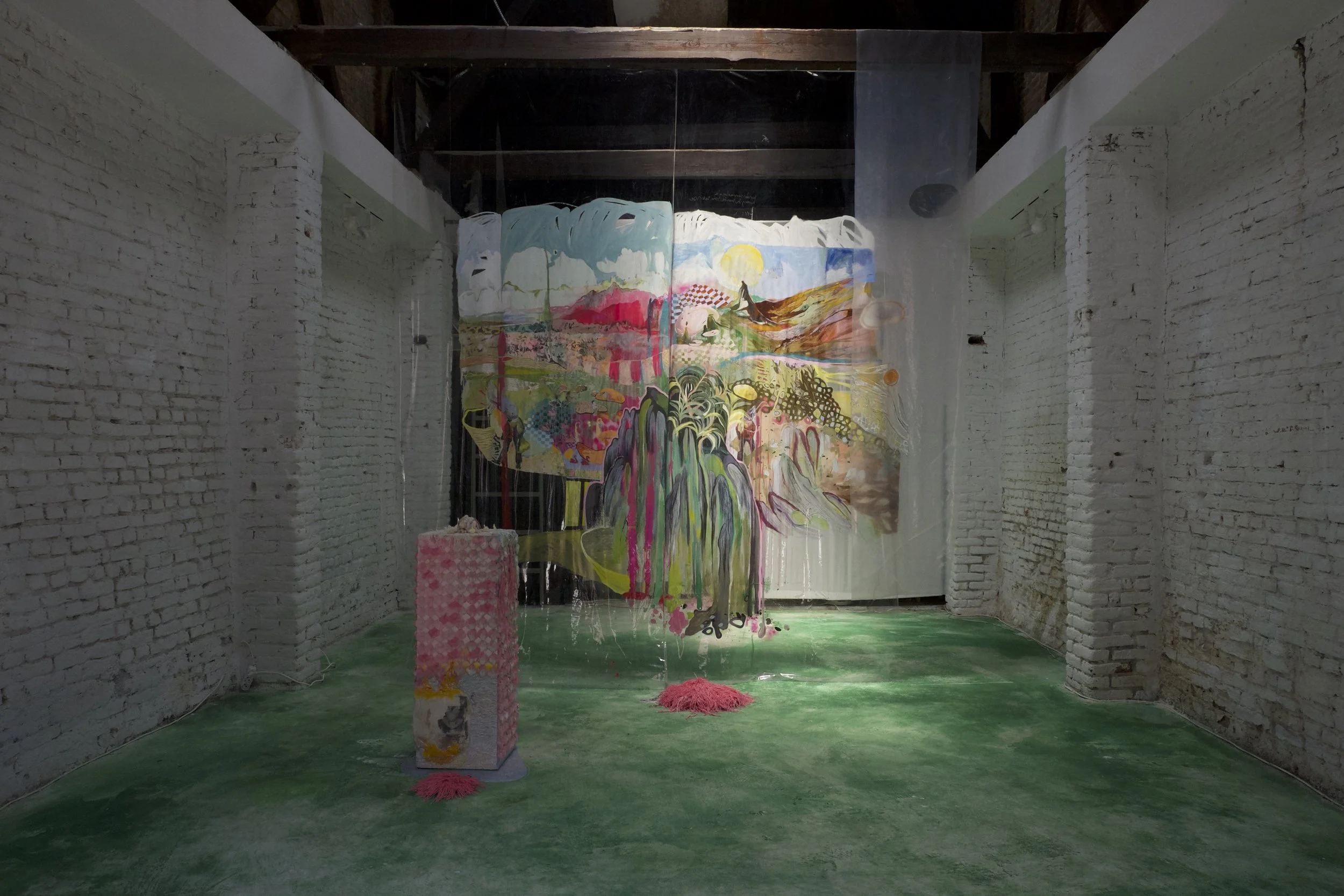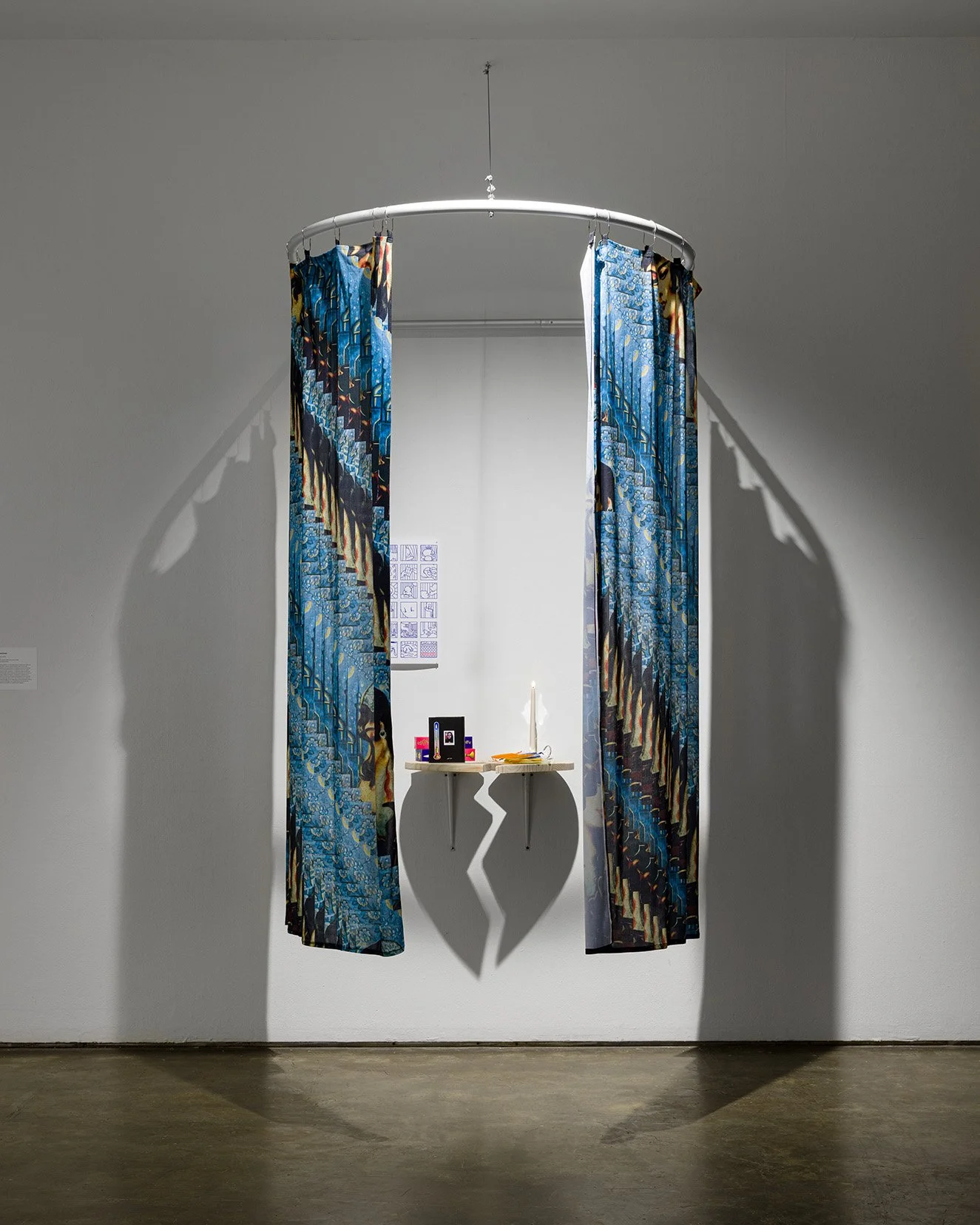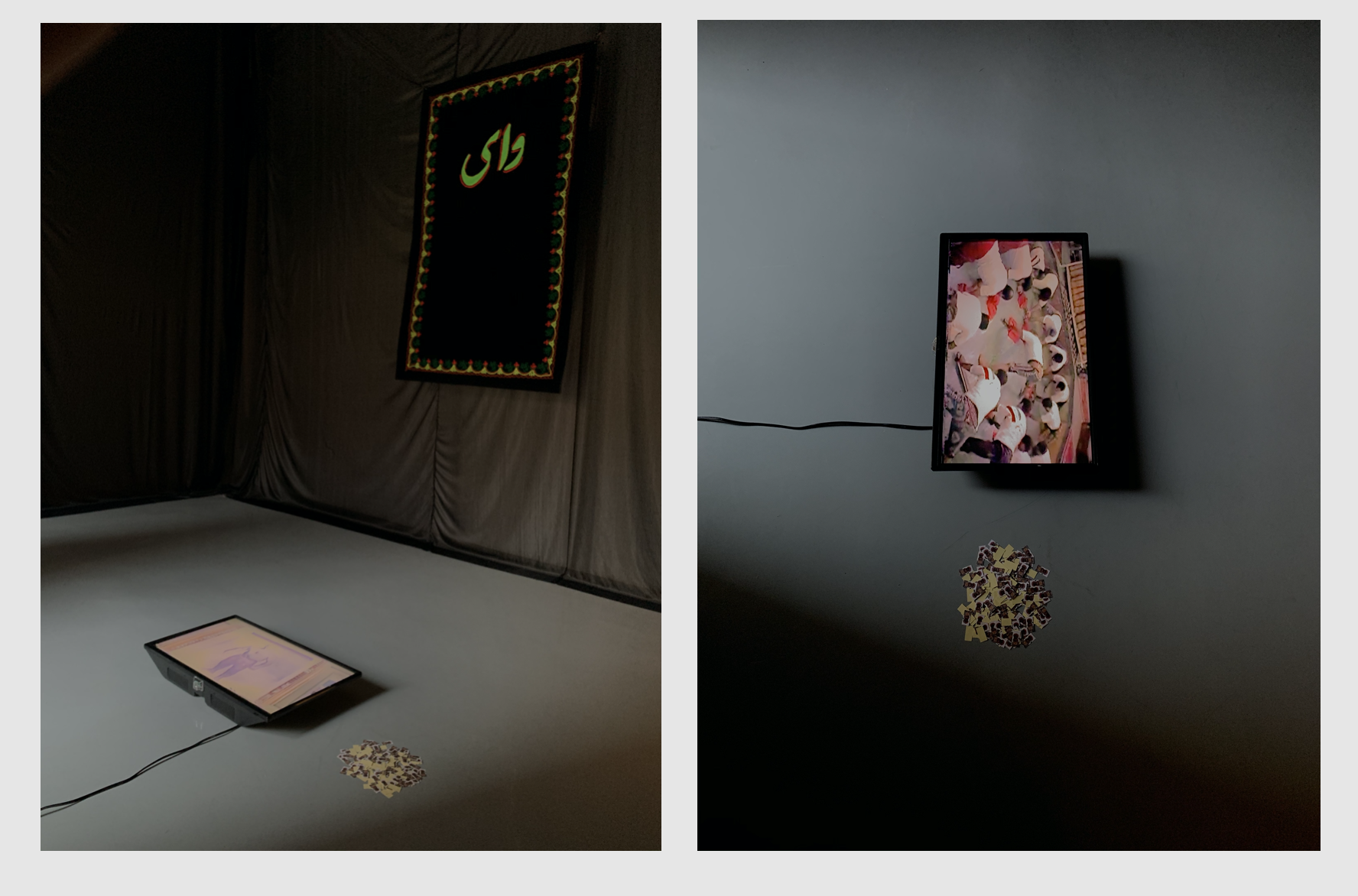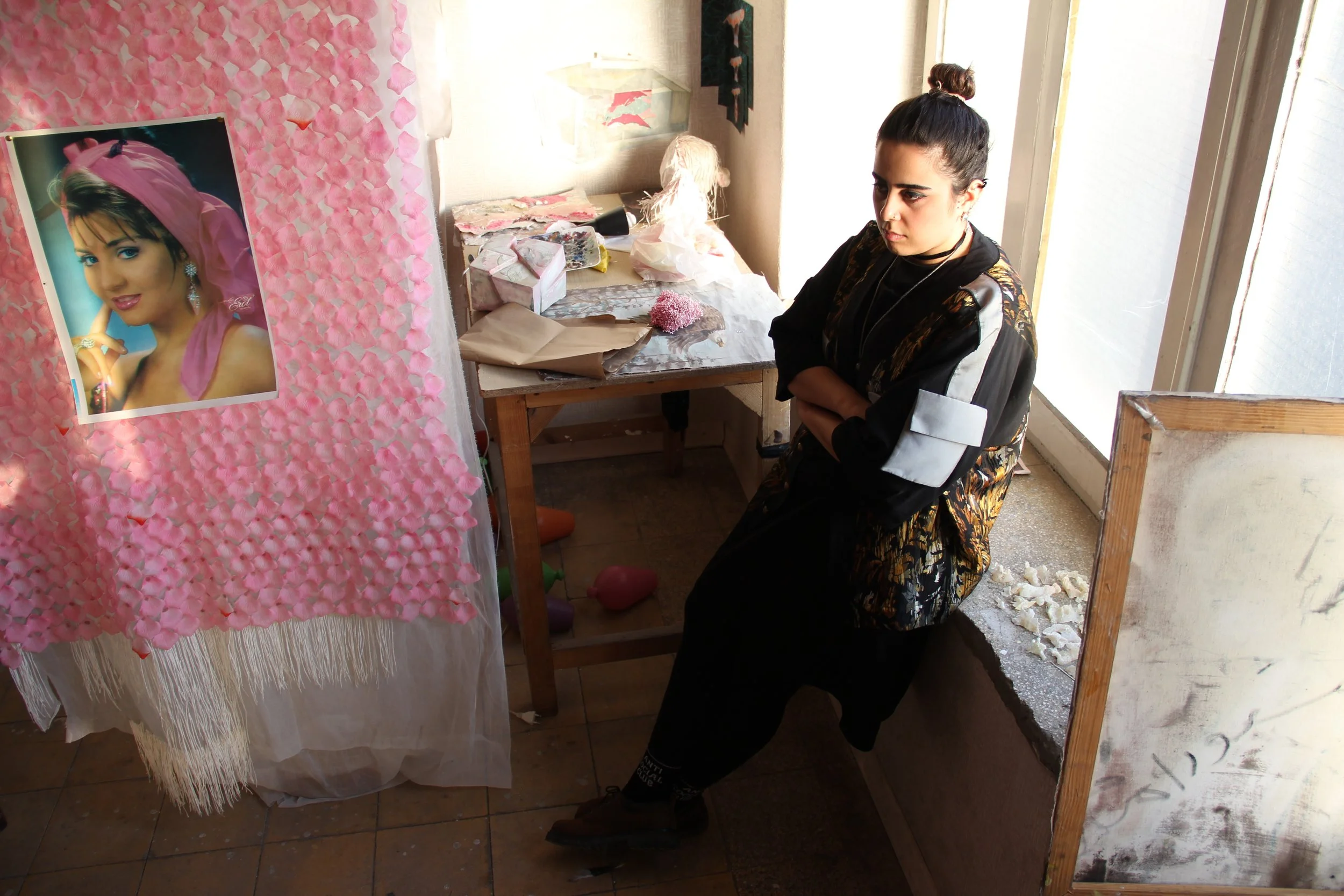Fatemeh Kazemi
BIO
Fatemeh Kazemi فاطمه کاظمی (b. 1992, Tehran) is a Syracuse-Based artist and Co-Founder of ROSVAÂ Magazine, pursuing her practice in multidisciplinary arenas to merge her different interests in different projects. She earned her Bachelor’s degree in Painting at the University of Tehran. Recently, she is studying for a Master of Fine Art in Studio Art at Syracuse University. Kazemi’s approach is focused on the process and context of creation, to spotlight the very period during which the work was built. She employs an amalgamation of media such as video, installation, writing, and performance that serve as research into themes of ritual, subculture, and archival memory. She uses a multitude of sources as a starting point, from theoretical text to a new word or memory, to weave together.
ARTIST STATEMENT
I think of myself as a cook, putting together data and incorporating archives of both familiar and strange tastes. I borrow flavors from my faraway childhood memories, and merge them, these shattered dreams, to mold stories of lost and forgotten things, double lives, and imaginary lovers. Also, this story emerges as a unique experience, a history that brings people together all the while allowing them to digest and disintegrate. Thus, I mingle with archives of original and found footage to stimulate intersecting emotions of sadness and happiness.
My artistic practice explores narratives through my focus on materials and their manifestation by employing a mixture of different media such as video, sculpture, zine, and installation. The initial stage of my practice, as visual research, revolves around an idea that comes from different sources like a theoretical text or even a word. Ultimately, they all intertwine with the piece that both have transient qualities and are more like wall objects rather than mere paintings.
Interview with Fatemeh Kazemi
Can you tell us a bit about your background and how you became interested in becoming an artist? Can you tell us about some of your most memorable early influences?
It is very difficult to find the roots of art in my family. As a girl, I grew up in a religious family with all conflicts around being in a traditional/conservative environment. From the beginning, the domestic spaces influenced me a lot. As an artist who was living in Iran, I am confronted with the rigid masculinity present in our society on a daily basis. The gender stereotypes placed upon us by government systems and religion through generations have seeped into the routine of life. It is present in the law of our country. It is present in every interaction I have with men and women. It is present in my relationship with my father. When I think about our relationship, in many ways I realize that he raised me “like a man”-- to be strong and independent. Yet our relationship shifted as I started puberty. Closeness was no longer appropriate. My father himself is by no means a “man’s man” -- he is not strong, he is not handy; he is quite emotional. Thinking and working about my dad is an integral part of my career have always been challenging and inspiring.
Where are you currently based and what brought you there? Are there any aspects of this specific location or community that have inspired your work?
I am currently at Syracuse University in New York pursuing graduate studies on a fellowship. Being here is my first immigration experience. I can't deny the fact that being somewhere outside of the environment where my body is used to living is a strange feeling. In this experience, I saw language as a barrier. Thinking, translating, speaking, and ultimately, failing to express myself from Farsi to English became much more prominent and frustrating with my migratory experience. I noticed this same frustration when I go back to Iran. Language has become a focus in my recent work. In the form of the process of fermentation of language in the body and the role of the tongue in this process and how the tongue works as a muscle to ferment the memory.
What is your studio space like? What makes your space unique to you?
I have a background in painting, set design, and theater. I see my studio space very much as a stage. I think I've developed this view more so in the last few years. I usually begin my research with a visual board that culminates in a collage of Iranian visual culture: screenshots from social media, popular culture references, Shia religious texts, etc. I build upon this research by collecting found objects from local market spaces that are commercially mass-produced, or essentially mostly available at a very low price and considered mundane. This process is part of my archival practice where these kitsch objects are associated with a middle-class identity. Familial photos also occupy a very important part of my studio walls.
What is a typical day like? If you don't have a typical day, what is an ideal day?
Being a grad student is a full-time job. I like to have my day planned out so I can go with a rigid schedule to balance my coursework with my art practice. While a portion of my day is dedicated to the studio or in the library, most of my time is spent in digital spaces and social media. I co-run a fashion brand based in Iran, NONIST, with my partner and co-run a digital magazine, ROSVÂA. In addition to studio time, social gatherings are very important to me. I am a co-stewardess and co-organizer of regular and irregular collective dining gatherings, such as Hosting Kinship in Los Angeles and Stone Soups in Central New York. Organizing gatherings is important to me for building solidarity, sharing, and collective thinking.
What gets you in a creative groove or flow? Is there anything that interrupts your creative energy?
In a collective, thinking and talking are very important, and along with that, collaborating with artists, depicting my activity, and practicing with friends and other bodies are helpful. Multifaceted activities, multi-person thinking and even cooking, reading with others, activities in the context of domestic spaces, and turning domestic spaces into my studio space have a significant impact on my daily practice.
Being isolated from others and having my studio become an echo chamber can disrupt my flow. At the same time, it’s also comforting when I unwind after bad critiques, etc.
How do you maintain momentum in your practice?
In my opinion, creating continuity and active dynamics in practice is the most important part of artistic activity. I always struggle to find one or more paths. I think the most important element for me is to think and try to create an atmosphere of mental and physical rest within the daily practice itself so that the body sees the continuation of the activity as part of the process.
Meadows and Mountains, 2019. Installation. Collaboration with Istanbul-based artist Zehra Nazli.
What medium/media are you working in right now? What draws you to this particular material or method?
I have always described myself as an interdisciplinary artist and currently, my work is very moving between medium. The medium is really intuitive and fluid, so I stitch them together purposefully. From words to casting with aluminum and editing video glitches in the software spaces.
Considering that I work with different materials, including archives, when I decide to start experimenting with a material, I must answer a series of questions myself to choose my material.
Can I navigate myself in that material?
Is that visual content (such as photo, video, or text) distorted in the process of practicing on it, and is there a possibility of exploiting the content?
How can I relate myself to material according to my identity, my background, and the class I belong to and consider it as part of my practice?
Can you walk us through your overall process in making your current work? Does drawing play a role in your process? What is exciting about your process currently?
I am excited to have access to shops at my university and am focused on taking advantage of these resources. I am learning new skills, like aluminum mold making, metal welding, and 3D rendering. I view these skills, crafts, or mediums as tools to make objects, so am not focused on becoming an expert. My recent installation, “Moving Objects/Physical Objects are nurturing objects outside” builds on a more significant bodywork, “poor knee, trigger finger.” I used a variety of materials, moving images on a monitor, satin curtains, latex, metal chains, and aluminum molds of grapes, and found resin grapes from an Iranian bazaar.
Despair and Die, 2022. Installation. Part of Always In My Heart at Smack Mellon (Brooklyn, NY) currated by Muheb Esmat.
Can you talk about some of the ongoing interests, imagery, and concepts that have informed your process and body of work over time? How do you anticipate your work progressing in the future?
Researching and working with narratives and sub-narratives is an ongoing interest for me. Most of the time these narratives are tied to my gender as a woman in Iran and more than individual. Other times, it is tied with a dream or memory that leads to many different crossroads. I think about bodily capabilities and bridging the body and language structure, specifically body intelligence and transforming energy from an invisible potential of a muscle experience with the tongue to a visual material. Since I immigrated, my tongue is strained to try to articulate what is internal/felt to the external/verbal.
There is a particular muscle memory associated with the tongue itself. One must exercise the tongue by using opposing, conflicting motions. This is clearly presented in my work with fragmented poems I write that use a blend of Persian and English languages to emphasize unintelligible words (misspellings, mispronunciations, censorships, etc.) as an unfiltered form of language that is in my mind.
Do you pursue any collaborations, projects, or careers in addition to your studio practice? If so, can you tell us more about those projects, and are there connections between your studio practice and these endeavors?
Most of my time is spent in digital spaces and social media. I co-run a fashion brand based in Iran, NONIST, with my partner and co-run a digital magazine, ROSVÂA. In addition to my studio practice, social gatherings are very important to me. I am a co-stewardess and co-organizer of regular and irregular collective dining gatherings, such as Hosting Kinship in Los Angeles and Stone Soups in Central New York. Organizing gatherings is important to me for building solidarity, sharing, and collective thinking.
Can you share some of your recent influences? Are there specific works—from visual art, literature, film, or music—that are important to you?
I am influenced by Ariella Azoulay’s “Potential History: Unlearning Imperialism” and Fred Moten and Stefano Harney’s literary collaborations.
Curse be upon the hope of those hopeless people, 2020. Video installation, consisting of three flags made in reference to traditional Shia flags of mourning with an accompanying video component. This installation reflects on the rigid gender and sexuality tropes culturally reinforced in Iran, and their effects in the artist’s own personal relationships, specifically with her father.
Who are some contemporary artists you’re excited about? What are the best exhibitions you’ve seen in recent memory and why do they stand out?
Shahryar Nashat and Jumana Manna. Jumana Manna currently has a show at Moma PS1 (“Break, Take, Erase, Tally”) that resonates with me. I was inspired by her documentary films exploring how food, autonomy, and agriculture affects social geographies, which intersects with my own upbringing. Ritualizing labor is a common survival mechanism throughout the Middle East.
Have you had any epiphanies recently that have changed the course of your work or caused you to shift directions? Do you have any tips or advice that someone has shared with you that you have found particularly helpful?
“Everything is everything and nowhere is home” is a phrase that came into my mind as I was traveling for a residency recently. I realized that my body is becoming used to being in transit and in a state of constant change. “Everything is everything” was a line being repeated in a Lauryn Hill song on the radio. It felt so profound and relevant to how I felt at that moment and I playfully repeated “nowhere is home” to myself. My advice is to trust and listen to your body.
What are you working on in the studio right now? What’s coming up next for you?
Currently, I am simultaneously working on a short film and a collection of objects related to the visual space of the film. These objects that I am in the process of making are found in domestic spaces, such as photo frames, boxes, candlesticks, clothes racks, vases, etc.
To find out more about Fatemeh Kazemi check out her Instagram and website.







